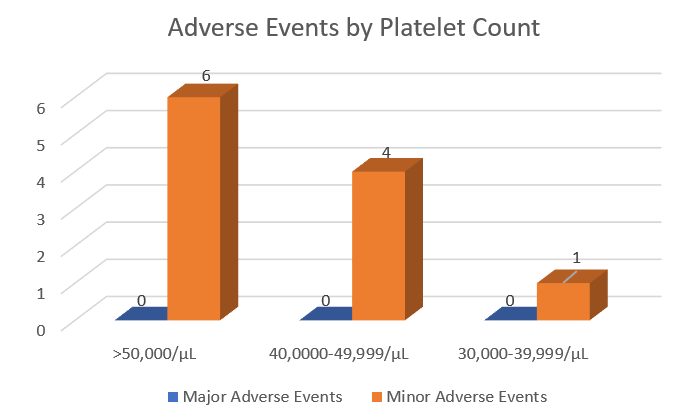Background: Lumbar Punctures (LPs) are generally considered to be safe bedside procedures, but when bleeding complications arise they can be catastrophic with epidural hematomas risking spinal cord compression and paralysis if untreated. Our institution serves a large number of patients with hematologic malignancies requiring intrathecal chemotherapy, sometimes as frequently as twice weekly, who often have higher bleeding risks due to low platelets. Platelet transfusion in this population is frequently complicated by consumptive pathology and the need for HLA matching. Our hospital system recently decreased its platelet cut-off for lumbar punctures from 50,000 to 40,000/µL. We retrospectively reviewed our database to determine whether the change in protocol has been associated with a change in the rate of adverse events.
Methods: We performed a retrospective review of data from January 2018, at which time the decreased cut-off was implemented, through October 2019. The rate of adverse events between LPs performed with platelets less than 50,000/µL, was compared to those performed with platelets greater than 50,000/µL. Major adverse events (AEs) included any neurological changes following LP, or death. Minor AEs such as bruising, traumatic tap (any visible blood or an elevated red blood cell count on analysis), and post LP- headache were also reviewed.
Results: Between January 2018 and October 2019 687 LPs were performed. Of those, 567 (83%) were performed with platelets ≥50,000/µL and 106 (15%) were performed with platelets 40,000-49,999/µL. On rare occasion (14 LPs, 2%), LPs were performed with platelets between 30,000-39,999/µL with additional platelets being infused during the procedure due to rapid platelet consumption, procedural urgency, or transfusion resistance. In all three groups, no major AEs were noted. In the ≥50,000/µL platelet group there were 6 (1.1%) minor AEs including five traumatic taps and one small subdural hematoma in a patient with significant leptomeningeal malignant spread. In the 40-49,999/µL platelet group there were 4 (3.8%) minor adverse events including one post-LP headache and three traumatic taps. The 30-39,999/µL platelet group had one (7.1%) minor AE, a traumatic tap.
Conclusions: In summary, there were no major adverse events in patients who underwent lumbar puncture in any of the three platelet groups. The minor AEs were associated with no long term sequelae and are considered acceptable risks given the need for therapy in this population.These findings have important implications for individual patients and throughout the healthcare system. For the healthcare system, blood product resources can be more judiciously utilized and fewer blood products used translates to improved cost saving. More importantly, for individual patients, fewer transfusions means a lower risk of transfusion related complications and antibody development. This review supports the use of a lower platelet threshold for safe lumbar puncture performance.


